¶ Introduction
A runway is a rectangular area of an aerodrome prepared for the landing and take-off of aircraft.
The runway is the most critical part of an airfield. An accident on a runway will affect the airport availability and any accident on a runway generally causes several reasons of damage and injuries in real life.
As a pilot or active ATC (air traffic controller), you must respect elementary security rules presented in this document.
¶ Mandatory rules to know as a pilot
¶ A clearance is mandatory
In a controlled airfield and for a pilot, a clearance from the air traffic controller is mandatory to enter, back-track, cross, land and take-off on the runway.
With no clearance in a controlled air field, the pilot shall not enter and land on any runway.
Pilots must read back all these clearances.
Examples: ATC: Speed bird 5 4 6, line up runway 13 and wait. Pilot:
line-up runway 13 and wait, Speed bird 5 4 6ATC: Alitalia 1 4 4 5, runway 15, cleared to land, wind 100 degrees 6
knots Pilot: cleared to land runway 15, Alitalia 1 4 4 5.
¶ Runway using condition for landing and taking-off procedure
A landing procedure cannot be performed when the runway is occupied. A take-off procedure cannot be performed when the runway is occupied.
In controlled area, a pilot on short final shall make a go around procedure before the runway threshold if he has not received any landing clearance.
The pilot in command shall initiate a go around procedure if he can see any aircraft, vehicle or obstacle on the runway even though he has received a landing clearance from ATC. He must immediately inform the ATC about the go around.
¶ Runway use in non-controlled areas
When there is no ATC available in an airfield, you must give your intention using a self-announcement procedure on UNICOM 122.800 MHz frequency.
The first pilot announcing a landing (if he has the runway in sight) or take-off manoeuvres has priority on the runway.
Then, if a second aircraft wants to land, he has to wait or negotiate with this pilot a new priority in accordance with the current position of all aircraft.
¶ Mandatory rules to know as an air traffic controller
¶ A clearance is mandatory
In a controlled airfield, as an air traffic controller, it is mandatory to give a clearance to a pilot in order to let him enter, back-track, cross, land and take-off on the runway.
Without clearance, the pilot shall not enter and land on any runway.
Pilots must read back all these clearances.
¶ Runway using condition for landing and taking-off procedure
After being given a landing or taking off clearance, the runway available in front of the aircraft cannot be used until the aircraft has vacated the runway or has executed a go-around procedure.
After being given a landing or take off clearance, the runway cannot be used any more for a landing or a take-off before the aircraft who has been given the clearance has vacated the runway or has executed a go around.
An air traffic controller shall manage all runways with the best rate of usability. He must follow the basic rule described below:
When an ATC delivers a line up and take-off clearance, he has to make sure that the taking-off aircraft has enough time to free the runway before the following aircraft on final is landing.
¶ Runway occupied or runway free
¶ Definition
Whether the aircraft is controlled or not, a runway is considered occupied when:
- An aircraft or a vehicle is on the runway whether rolling, taxiing or waiting.
- An aircraft is landing on the runway from runway threshold until the touchdown
- An aircraft is taking-off until the runway limits are left
- An aircraft is making a touch and go or a low pass until the runway limits are left
- An aircraft or a vehicle are between the runway and the holding point bar
The runway is considered occupied if the different cases above will be effective with a clearance already given (taking off, landing, crossing, taxiing ...).
For example, a runway is considered occupied if: A landing clearance is already given to an aircraft whether the aircraft overflies the runway or not. A taking-off clearance is already given to an aircraft on the runway or at the holding point. A runway crossing clearance is already given to an aircraft until he vacates the runway.
Touch and Go, Stop and Go, Low Pass clearances are considered as landing and taking/off clearances.
For airports which have multiple runways, the bare basic of the security is the same, but some rules must be added. These special rules will be part of another document.
¶ Examples
Below, an example of an aircraft on runway taxiing, crossing, back-tracking, taking-off or landing:
Runway is occupied.

Below, an example of an aircraft in progress of a runway vacation but the holding point bar is not behind the aircraft:
Runway is occupied.

Below, an example of an aircraft which has vacated the runway:
Runway is free.

Below, an example of an aircraft which has performed its taking off and has vacated the runway after the opposite threshold:
Runway is free.

Below, an example of an aircraft which has performed its taking off and has vacated the runway with an initial turn before the opposite threshold:
Runway is free.

Below, an example of an aircraft behind the holding point which has received a take-off clearance or a line-up clearance:
Runway is considered as occupied.

Below, an example of an aircraft flying on final, which has received a landing clearance:
Runway is considered as occupied.

Below, an example of an aircraft which has received a crossing clearance:
Runway is considered as occupied.
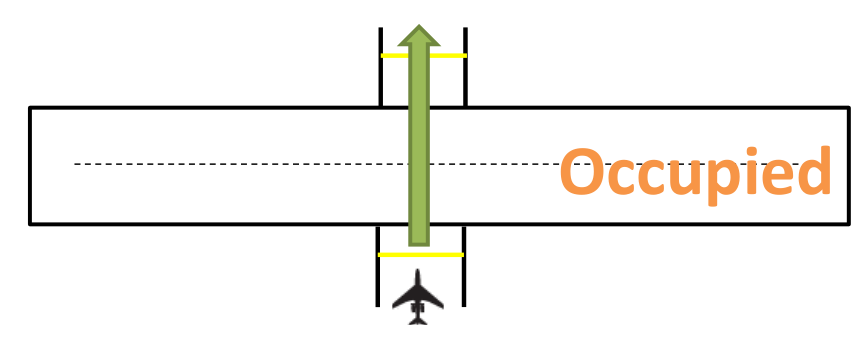
Below, an example of an aircraft which has received a back track (back taxi) clearance:
Runway is considered as occupied.

¶ Situation with two aircraft in one runway

¶ Basic situation with a line-up, taking off or landing aircraft
Below, the medium aircraft is holding at the holding point, ATC can give the take-off clearance to heavy aircraft and this aircraft can perform the taking-off.

Below, the medium aircraft is on the runway or overflying the runway, ATC cannot give any take-off clearance to the heavy aircraft and this aircraft cannot perform the taking-off.

Below, the heavy aircraft is landing or taking off and has crossed the position next to the holding point occupied by the medium aircraft, ATC can give the line-up clearance to medium aircraft and this aircraft can enter the runway only for line up operation or taxiing operation via the runway.

In the situation above, if the heavy aircraft is landing, there must be another free taxiway in order to vacate the runway without any backtrack. See backtrack operation at the end of this document to study one holding point operations.
Below, the heavy aircraft is on final before the runway threshold, ATC cannot give the line-up clearance to medium aircraft and this aircraft cannot enter the runway.

In the case above, the air traffic controller can use a conditional line-up clearance to speed up the management of the runway (only possible if country and airport regulation permits conditional clearance). The controller must verify that the pilot in the aircraft at the holding point can see the incoming traffic.
¶ Go around operation
Below, the medium aircraft is on final before the runway threshold and a heavy aircraft is on the runway taxiing, landing or overflying, ATC cannot give the landing clearance to the medium aircraft and this aircraft cannot land on the runway until the heavy aircraft has vacated the runway.

As the pilot in command of your aircraft, if the runway is not free and your aircraft is on short final (〈2NM), you must go around with no delay even if you have received a landing clearance.
As an air traffic controller, if the runway is not free and there is an aircraft on short final (〈2NM), you must order a go around clearance without delay. Be aware of air traffic separation if the first aircraft will not land!

¶ Multi alignment operation
In the largest airports, many holding points and vacating taxiways are available for each runway. These numerous holding points and taxiways are sometimes necessary to provide enough opportunities to the pilots to choose the best and quickest taxiway to vacate the runway.
As an air traffic controller, you can use these numerous taxiways and holding points for:
- Making homogeneous departure sequence
- Using multi alignment procedure
- Expediting light aircraft departure
Below, this is an example of multi-alignment operation. Both aircraft have received a line-up procedure. As air traffic controller advise the aircraft behind (here the heavy one) about traffic in front of him from another taxiway.
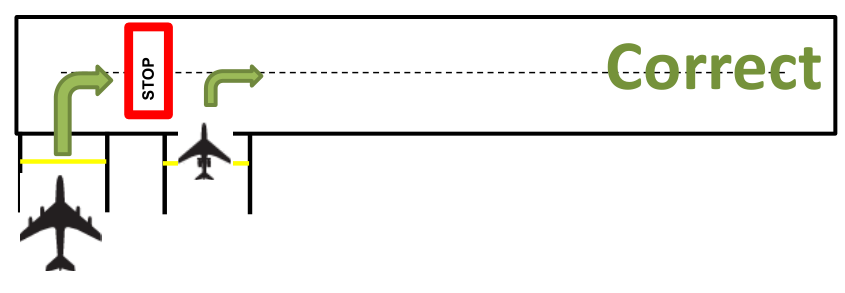
Below, the medium aircraft is holding position on the runway behind the heavy aircraft, ATC can give the take-off clearance to the heavy aircraft and this aircraft can perform the taking-off. The medium aircraft shall maintain his position until the heavy aircraft has vacated the runway.

Note that multi-alignment from different taxiways behind a taking off aircraft is authorized in order to optimize the taking off sequence.
Below, the heavy aircraft is holding position on the runway behind the medium aircraft lining up, ATC can give the take-off clearance to the medium aircraft and this aircraft can perform the taking-off. This situation can be used by the air traffic controller to expedite a light aircraft departure before a take-off of an heavier aircraft.

¶ Runway crossing operation
In some airfields, a runway crossing clearance is needed in order to let aircraft join an apron area, or a holding point. The runway crossing operation can be used in the same way like multi alignment operation.
Below, the medium aircraft is holding position on the runway and the heavy aircraft needs to cross the runway, ATC can give the crossing clearance to the heavy aircraft and this aircraft can perform the taxi.
The medium aircraft shall maintain position and must not perform any take-off operation.
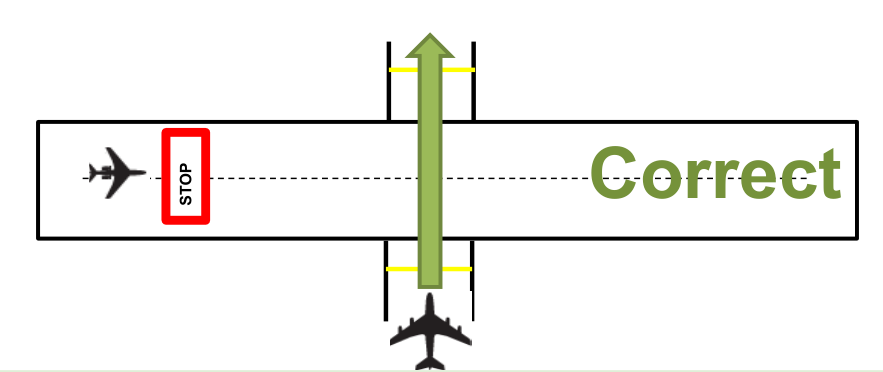
A runway can be used as taxiway when needed if the runway is free to use for this type of operation.
Below, the medium aircraft is moving on the runway (taxiing, landing, taking off or overflying) and the heavy aircraft needs to cross the runway, ATC cannot give the crossing clearance to the heavy aircraft and this aircraft must hold at the holding point. The medium aircraft shall finish its procedure.
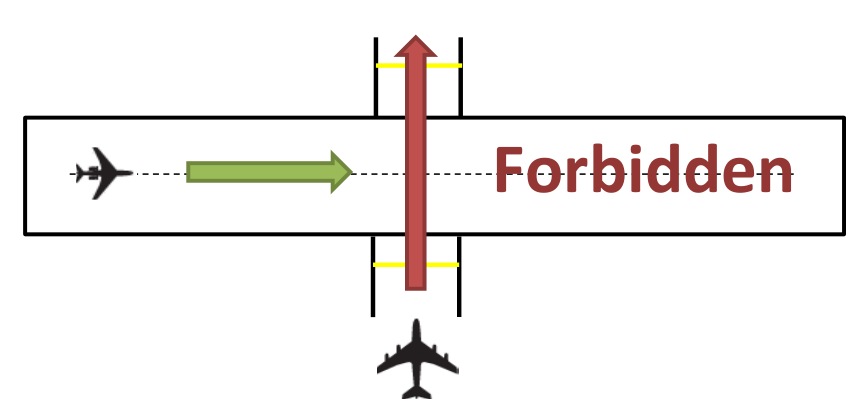
Note that a conditional crossing clearance behind a taking off or a landing aircraft should not be used for safety reasons.
Below, the medium aircraft has vacated the crossing taxiways after a landing, taking off or taxiing operation and the heavy aircraft need to cross the runway, ATC can give the crossing clearance to the heavy aircraft and this aircraft can perform the taxi.
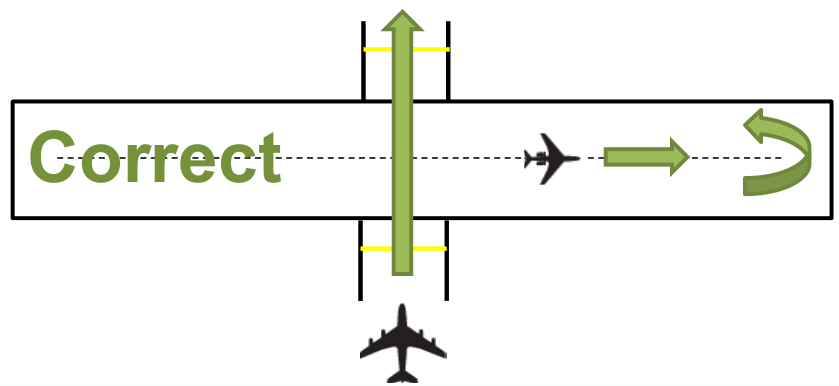
The heavy aircraft shall maintain the position and wait that medium has crossed the taxiway.
¶ Runway back-track operation
Some small airfields have few holding points and taxiways to exit and enter the runway. Sometimes the holding point is not located at the runway threshold. In that case, you must use the runway as taxiway in order to line up at the beginning of the runway. This taxi operation is called "back-track" (or back taxi in some countries).

Below, the medium aircraft is at the unique holding point of the runway, and the air traffic controller gives the take-off clearance but the aircraft needs the whole runway to take off, then ATC shall give a back-track clearance to the aircraft, followed by the take-off clearance.
Some IVAO beginners sometimes take the opportunity to taxi via the grass outside any taxiway and apron: this is a wrong operation if one taxiway exists.
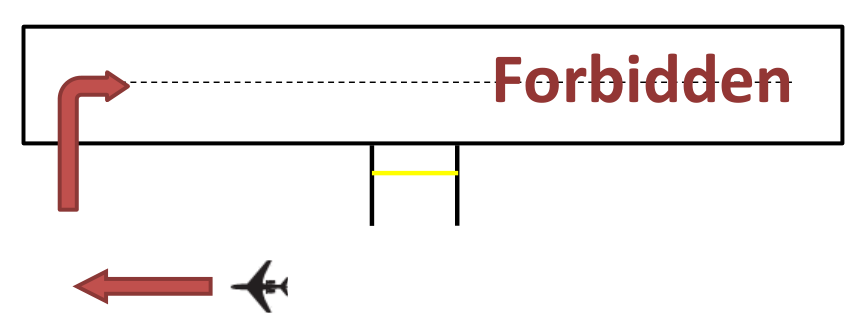
The aircraft shall not leave the taxiway or runway in order to join the runway threshold.
For an airfield with only one taxiway at the middle, and with two aircraft involved with the situation. The air traffic controller has already given a taxi clearance to a heavy aircraft to the unique holding point.
Below, the heavy aircraft is at the unique holding point of the runway, and the air traffic controller needs to give the take-off clearance but there is a medium aircraft on final which is currently landing.
The problem is that the heavy aircraft occupies the unique vacating taxiway and the landing medium aircraft will occupy the runway and cancel the take-off.
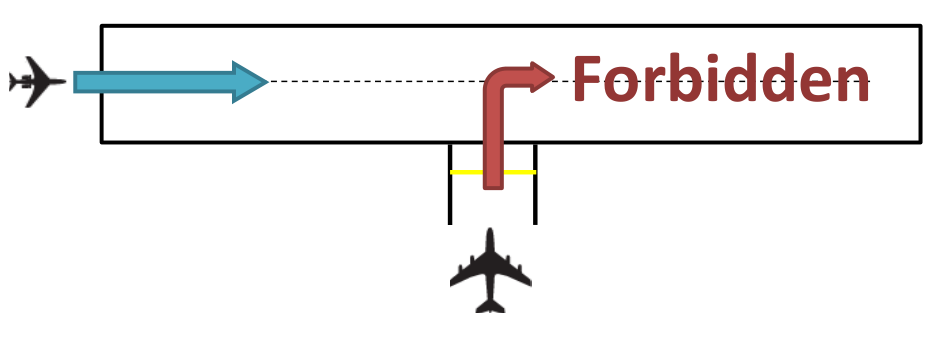
A simple solution is to use double back-track operation in order to avoid a go-around procedure of the medium aircraft:
- The solution is to give a clearance to the medium aircraft to continue to the end of the runway after landing, in order to let the heavy aircraft back-track to the beginning of the runway.
- Continuing this back-tracking procedure, the heavy aircraft will allow the holding point to be free for use by the medium aircraft.
- The medium aircraft will perform a back-track operation after a half turn and vacate the runway using the unique taxiway while the heavy aircraft will wait at the runway threshold. Then, the heavy aircraft can initiate the taking off without risk.
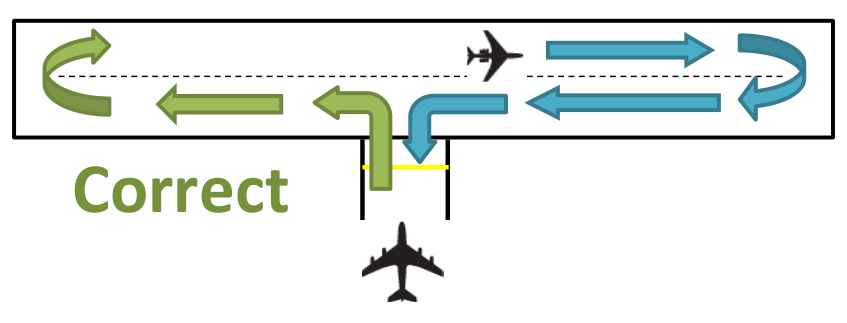
- none
- VID 150259 - Creation
- VID 150259 - Wiki integration